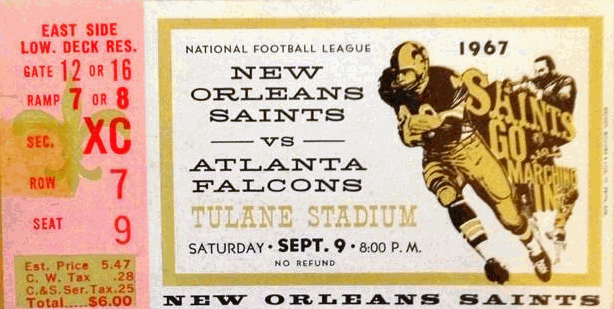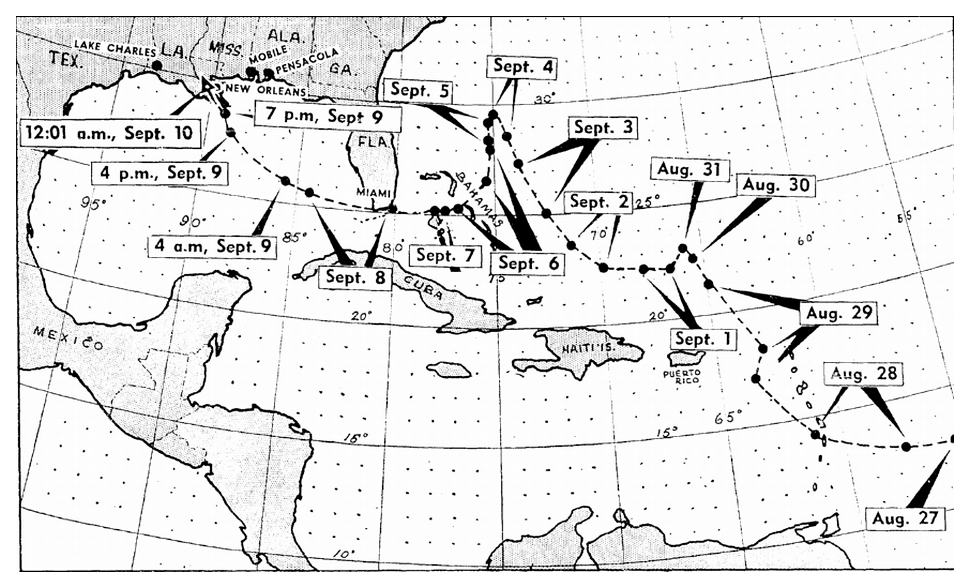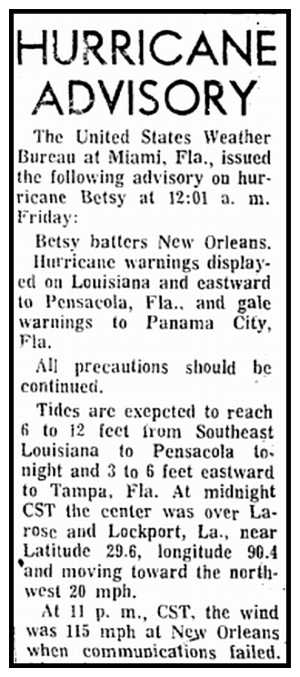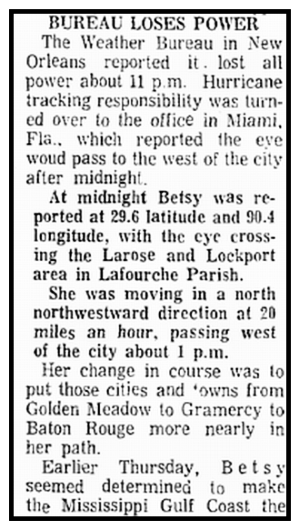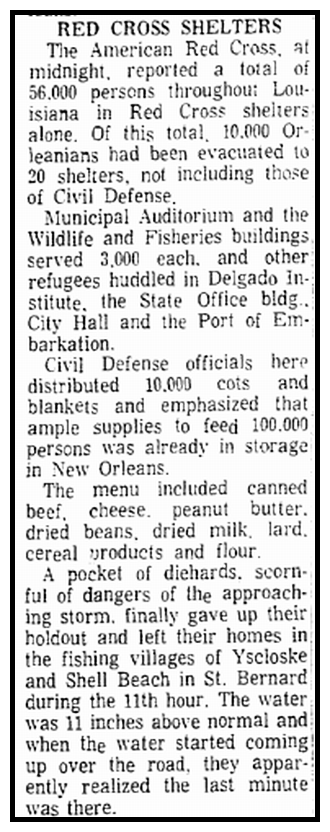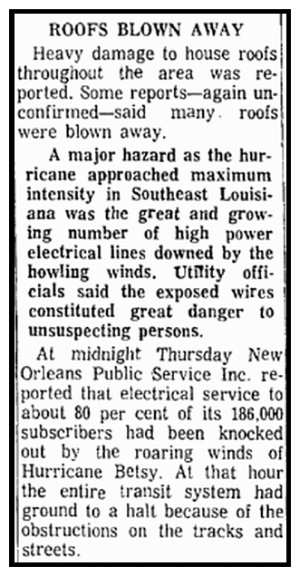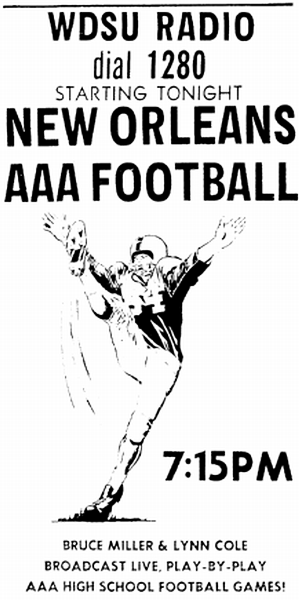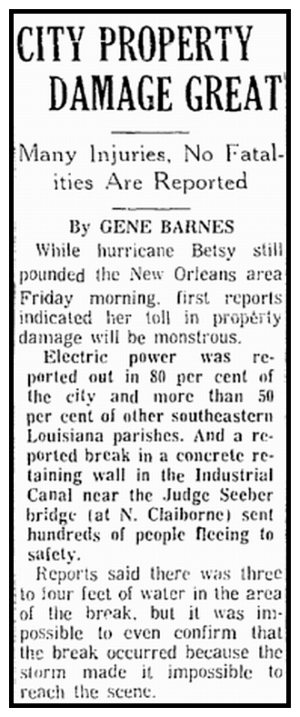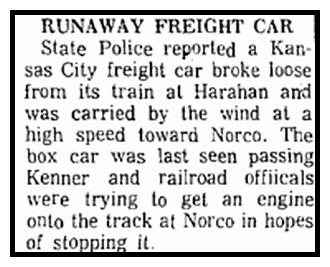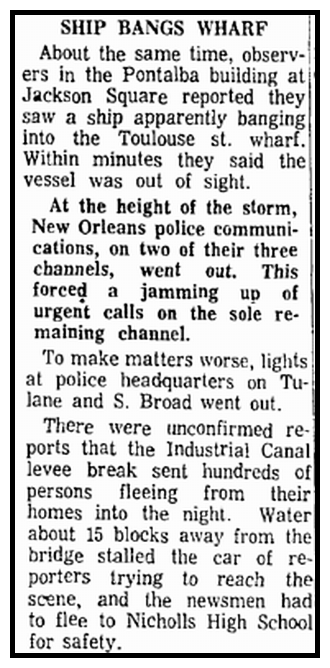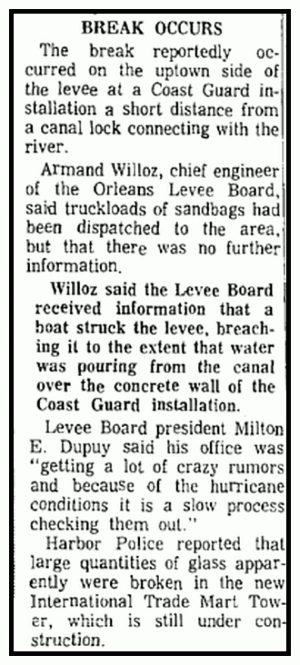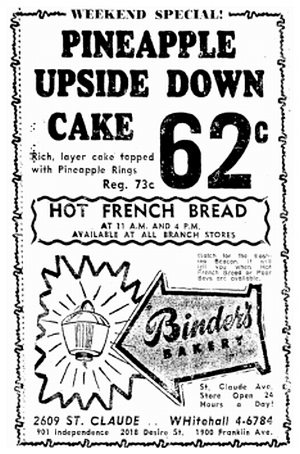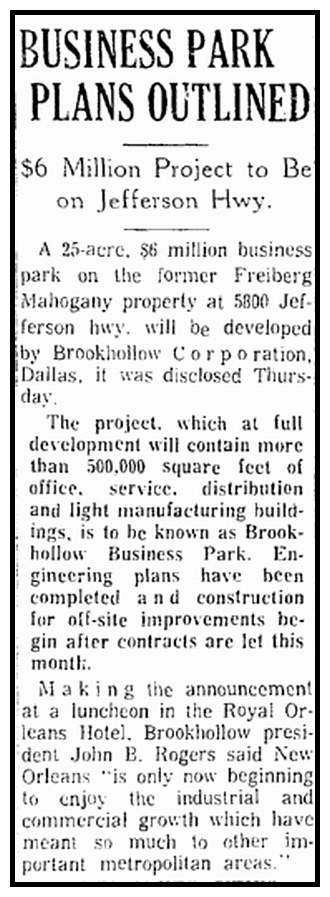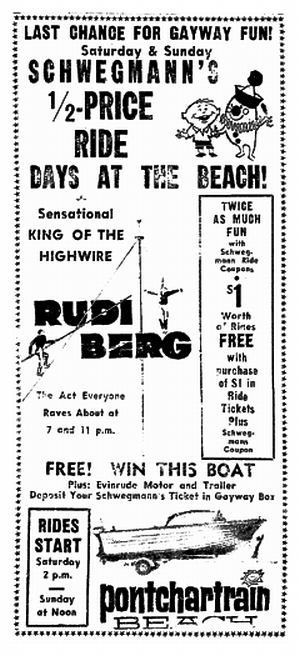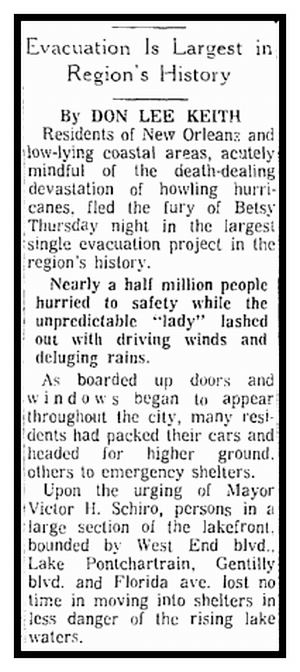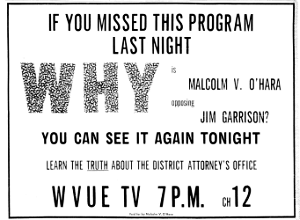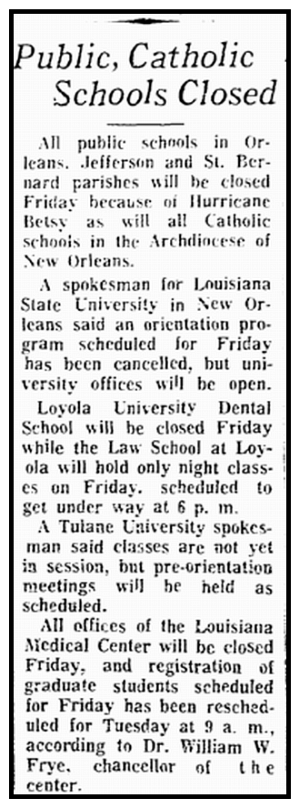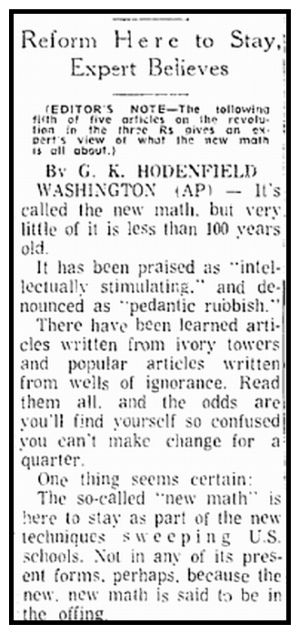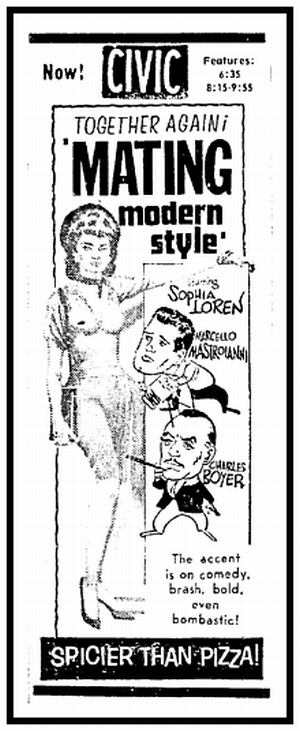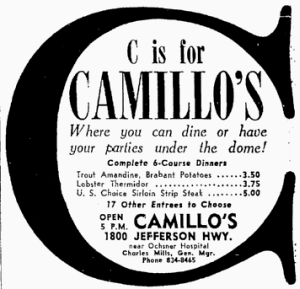|
Today in New Orleans History |
|
|
September 9


 To receive an update for each day in New Orleans history,
join our facebook page - Today in New
Orleans History.
 To receive an update for each day in New Orleans
history, join our facebook page
- Today in New Orleans History
|
|||
|
Hurricane Betsy Hurricane Betsy was the first tropical
cyclone in the Atlantic Basin to cause at least $1 billion (1965 USD) in damage. It was the third tropical
cyclone, second named storm, and second hurricane of the 1965 Atlantic hurricane season.
Betsy entered into the Gulf of Mexico and re-strengthened into a Category 4 hurricane on September 9. While approaching
the Gulf Coast of the United States, Betsy peaked slightly below the threshold for Category 5 hurricane status. However,
further intensification was halted after Betsy made landfall in Grand Isle, Louisiana later on September 9. Betsy
resumed intensification over the eastern Gulf of Mexico and became a Category 4 hurricane again by early on September 9.
Shortly thereafter, the storm turned northwestward and began approaching the Gulf Coast of the United States. While located
45 miles south of the Mississippi River Delta at 0000 UTC on September 10, Betsy attained its peak intensity with
maximum sustained winds of 155 mph and a minimum barometric pressure of 941 mbar.
A few hours later, the storm made landfall near Grand Isle, Louisiana at the same intensity. Betsy was
one of the most intense, deadly, and costly storms to make landfall in the United States. The storm killed 76 people in Louisiana.
Betsy caused $1.42 billion in damage, which when adjusted for inflation amounts to $10–12 billion (2005 USD).
Betsy was the first hurricane to cause damage in excess of $1 billion (based on damage at the time of the storm—many
storms before then have inflation-adjusted damage over $1 billion); the storm thus earned the nickname "Billion-Dollar
Betsy". Eight offshore oil platforms were destroyed during Betsy, with others experiencing damage. A Shell oil platform
off the Mouth of the Mississippi river was not seen again. The oil rig Maverick, owned by future president George H. W. Bush's
Zapata corporation also disappeared during the cyclone. Hurricane Betsy slammed into New Orleans on
the evening of September 9, 1965. 110 mph winds and power failures were reported in New Orleans.
The eye of the storm passed to the southwest of New Orleans on a northwesterly track. The northern
and western eyewalls covered Southeast Louisiana and the New Orleans area from about 8 pm until 4 am the next morning. In
Thibodaux winds of 130 mph (210 km/h) to 140 mph were reported.
The Baton Rouge weather bureau operated under auxiliary power, without telephone communication.
Around 1 am, the worst of the wind and rain was over. Betsy also drove a storm surge into Lake Pontchartrain,
just north of New Orleans, and the Mississippi River Gulf Outlet, a deep-water shipping channel to the east and south. Levees
for the Mississippi River Gulf Outlet along Florida Avenue in the Lower Ninth Ward and on both sides of the Industrial Canal
failed. The flood water reached the eaves of houses in some places and over some one story roofs in the Lower Ninth Ward.
Some residents drowned in their attics trying to escape the rising waters. These levee breaches flooded parts of Gentilly,
the Upper Ninth Ward, and the Lower Ninth Ward of New Orleans as well as Arabi and Chalmette in neighboring St. Bernard Parish.
President Lyndon Johnson visited the city, promising New Orleans Mayor Vic
Schiro federal aid. It was ten days or more before the water level in New Orleans went down
enough for people to return to their homes. It took even longer than that to restore their flooded houses to a livable condition.
Those who did not have family or friends with dry homes had to sleep in the shelters at night and forage for supplies during
the day, while waiting for the federal government to provide emergency relief in the form of trailers. In all, 164,000 homes
were flooded at the second landfall. Evidence suggests that cheap construction and poor maintenance of the structures
led to the failure of the levees. The U.S. Army Corps of Engineers'
Hurricane Protection Program came into existence as a result of Betsy. The Corps built new levees for New Orleans that were
both taller and made of stronger material, designed specifically to resist a fast-moving Category 3 hurricane like
Betsy. The resulting levee improvements failed when Hurricane Katrina, a large, slow-moving, intense hurricane made landfall
near New Orleans on August 29, 2005. Because of the significance of its damage in the Bahamas, southern
Florida and the Gulf Coast, the name Betsy was retired from the recurring list of names; the name "Betsy" will never
again be used for an Atlantic hurricane. It was replaced by the name Blanche for the 1969
season. From http://en.wikipedia.org/wiki/Hurricane_Betsy
Reverend Alfred Lawless was born in Thibodeaux, Louisiana on July 16, 1872. He attended Straight University
in New Orleans from which he graduated with a Bachelor of Arts degree in 1900 and Bachelor of Divinity degree in 1902. In
1904, he founded Beecher Memorial Congregational Church. In August 1913, he became principal of Fisk Colored School, the first
public school in New Orleans to provide modern instructional equipment and adult education classes to African Americans. Lawless
became the Superintendent of Negro Congregational Churches in the South in 1917. Reverend Lawless died in Atlanta on September
9, 1933 and is buried in Mount Olivet Cemetery. The Lawless Memorial Chapel on Dillard University's campus is named
in his honor. (NOPL) Earl Humphrey, born in New Orleans on September 9, 1902, was an American jazz trombonist.
He was the brother of noted New Orleans jazz players Willie Humphrey and Percy Humphrey. Earl Humphrey learned to play trombone
from his grandfather, and joined a traveling circus with his father in 1919. He traveled widely in the 1920s, and in 1927
recorded with Louis Dumaine. He played through the 1930s but retired to Virginia in the 1940s. In 1963 he returned to New
Orleans, where he was urged to resume his musical career. He joined his brother Percy's band and played on a few albums,
including Jazz City Studio. He recorded his first sessions as bandleader in the mid-1960's; Igor's Imperial Orchestra (1966)
and Earl Humphrey & His Feetwarmers (1967) on the Center label. Earl died at his home in New Orleans on June 26, 1971
at the age of 68. (WIKI) |
|
Street Name Changes Several New Orleans street
names were changed or created on this day in 1909. The former Julia Street in Lakeview, from the Greenwood Cemetery
line to West End Boulevard, was renamed West End. Kennedy Place wa created from a square bounded by Ursuline, Bell, Lopez
and Rendon Streets.
Federal Emergency
Management Agency (FEMA) Director Michael Brown was removed from directing Hurricane Katrina relief efforts in New Orleans
by Homeland Security Secretary Michael Chertoff. He has been replaced by Vice Admiral Thad W. Allen, Chief of Staff of the United States Coast Guard. U.S.
Army Lieutenant General Russel L. Honoré and New Orleans Director of Homeland Security Terry Ebbert announced a "zero access" policy with regards to the
media, in order to prevent members of the media from reporting on the recovery of dead bodies in New Orleans. CNN filed
a lawsuit, then obtained a temporary restraining order to prevent government agencies from
interfering with news coverage of recovery efforts. 42,164 Army National Guard and 4,347 Air National Guard were deployed
(46,511 total).
|
|
|

To receive an update for each day in New Orleans history,
join our facebook page - Today in New
Orleans History.
Analytics |
|||
